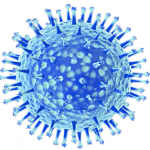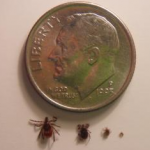General Epidemiology
Student guest post by McKenzie Steger
Off the southeastern coast of Australia lies a small island that in the 1700 and 1800’s was inhabited by the very worst of Europe’s criminals and is now the only natural home in the world to a species named after the devil himself. Decades later beginning in 1996 Tasmanian devils were going about their nocturnal lifestyle in normal devilish fashion feasting on small mammals and birds, finding mates and reproducing, occasionally fighting with one another and so on. (1) Just as criminals divvied up their booty hundreds of years before, the devils were…
Student guest post by Sean McCaul
Image Source: http://www.cejournal.net/?p=1934
The next time somebody in your office or household has the flu, you might want to consider keeping your distance. A new study published this month in Nature Communications suggests that about half of the transmission of influenza A results from inhalation of microscopic infectious droplets created by the coughing and sneezing of people infected with the flu. The flu virus hitches a ride in these droplets, and may infect nearby susceptible people who breathe them in.1
The influenza A virus…
Student guest post by Bradley Christensen
No, this isn’t a clip from a science fiction movie. Although dramatic, this does occur in the brains of some people and animals around on our home planet. What is a prion you ask? Prions are almost as mysterious to the scientists that research them as they are to me, you and the neighbor down the street. Prion is a term used to describe an abnormal and particularly destructive strand of protein found in the brain. Proteins are the building blocks of the muscles and tissues of our bodies that work combine together to…
Student guest post by Kyle Malter
In many areas of the country there is a vile blood sucker that lurks in our forests, our parks and even our backyards. What concerns us is not what this creature takes but rather what it leaves in our body after it bites us: corkscrew shaped bacteria called spirochetes and with the name Borrelia burgdorferi. When the bacteria invade our bodies and cause problems along the way we call it Lyme disease.
It is Lyme, not “Lymes” disease, and here’s how it got that name. In the early 1970’s a large number of cases emerged involving children with a…
Student guest post by Julia Wiederholt
I don’t think there is a single person that can claim to have never had the joyous experience (sarcasm intended) of suffering from the influenza. We all recognize the common symptoms that accompany this infectious little virus taking up residence in our bodies: the chills accompanying a fever, the total body ache, the nausea, and overall feeling of malaise. Typically this virus comes and goes within a week without serious side effects. When novel strains of the influenza pop up however, there can be more serious complications as your…
Student guest post by Brandon Woods
A Dangerous Paradise
From jungles with jaguars to crystal blue lakes with freshwater sharks, Nicaragua is one of the most beautiful and dangerous countries in Central America. The brilliant biodiversity attracts millions of tourists each year and the looming volcanoes that pepper the landscape can be an exciting yet unsettling sight. However, in reality much of the danger in Nicaragua comes from the risk of infectious diseases. For example, if you’re planning to travel to this tropical paradise anytime soon, the Center for Disease Control (CDC) states that…
Student guest post by Carrie Ellsworth
During the summer of 2010 I spent two months in Ghana studying a parasite called schistosomiasis. We worked in a small town called Adasawase to determine prevalence and treat the schoolchildren who were infected. We were told that schistosomiasis was not a major health concern for the people in the town because they were often faced with other diseases that had more immediate and severe health consequences than a parasitic infection. It became apparent that if we wanted the people of this small town to take this health threat seriously, we needed to…
Student guest post by Molly Stafne
Nothing could be worse than watching your seven-year-old lying in a hospital bed fighting for his life after being diagnosed with hemolytic uremic syndrome. Unfortunately, Mary McGonigle-Martin experienced it first hand as her son, Chris, fought for his life after being poisoned by E. coli 0157:H7 found in contaminated raw milk. Like many mothers, Mary was coerced into believing the inaccurate “facts” given to her by the farm she purchased raw milk from. Too often across the US, parents are given incorrect information about the safety of the milk they drink…
Student guest post by Naomi Kirschenbaum
Although we can never know, there are estimates in the range of 15,000 displaced pets in the wake of 2005 Hurricane Katrina. Many of the dogs found their way to shelters and homes in our community around the Monterey Bay in California. As a local veterinarian the most notable observation I saw was how it “seemed” that so many were heartworm positive. Six years later we have a published study finding a 48.8% prevalence of heartworm in these dogs.
This story is an example of a few important lessons. First, how things seemed to me…
Student guest post by Jack Hamersky
After successfully completing a job interview I had the opportunity to take the next step in my employment process: taking a Tuberculosis or TB test. I have received the test before but never really understood the point of testing for a disease no one ever sees in my community. I always thought, “Why not focus all this effort and money on more prevalent infectious agents such as Ebola or HIV?” You know, focus on something important. So, as the nurse called me in from the waiting room I began to curse that hard little bubble that would soon be…
It's time for this year's second installment of student guest posts for my class on infectious causes of chronic disease. Third one this round is by Jack Walsh.
The Human Immunodeficiency Virus (HIV) infection is one of the most significant global health challenges of this 21st century. Since the isolation of the virus in 1983, it has infected 70 million people among whom 35 million have died of Acquired Immunodeficiency Syndrome (AIDS).1 Although important progresses have been made in slowing down the pandemic and reducing the morbidity and mortality related to HIV/AIDS with…
Temple Grandin is undoubtedly one of the most famous women with autism of our time. Trained in animal science, Dr. Grandin is a widely read author and noted speaker on autism. April is National Autism Awareness Month, and Dr. Grandin has a new book out, "The Autistic Brain." Together, this must have seemed like a good time for the New York Times to interview her. Unfortunately, the interview is superficial and not very illuminating, and what Dr. Grandin does say is disappointing. Her take on vaccines and autism, which apparently is elaborated upon in her new book:
Q: In your new book, “The…
I have a new article up today at Slate, examining the emergent H7N9 avian influenzas, and a bit of a review of "bird flu" in general:
While we were carefully watching H5N1 in Asia and Europe, another influenza virus—2009 H1N1—appeared seemingly out of nowhere. Ultimately traced back to swine, this virus was easily spread between people, but unlike H5N1, it wasn’t any more deadly than our normal yearly influenza viruses (which, it should be noted, still kill on the order of 36,000 Americans each year). And now, while we’re still working on understanding how H5N1 and H1N1 have jumped between…
Dear Pa,
I know you care deeply about many issues, especially social justice. You're tired of wars, you're ashamed of the attempts to destroy social programs in this country, you hate seeing the unions that helped you as a worker provide for our family get dismantled by wealthy CEOs whose only goal is to make themselves and their cronies more wealthy. These are noble things to believe in, and values that you've instilled in your children.
But you probably don't often consider how you select and digest (and frequently, share on Facebook) the stories that you'll accept as true. This is called…
I have a post up today at the Scientific American Guest blog, discussing how an earthquake and denial led to prairie dog plague. It details an outbreak of plague in Victorian San Francisco--the first time plague hit the United States--and the many downstream consequences of that outbreak (which began in 1900 and wasn't really contained until 1908). While the story is over at SciAm, here I wanted to talk more about why the outbreak became such a public health disaster.
The outbreak was first recognized by Dr. Joseph Kinyoun, a bacteriologist who had been, until his transfer to San Francisco,…
I discuss the topic of emerging infectious diseases today over at Slate, as part of their Pandemic series.
Ebola has long been known to be a zoonotic virus--one which jumps between species. Though it took several decades to find evidence of Ebola virus in bats, these animals had previously been associated with human index cases of Ebola disease have worked in bat-infested warehouses or traveled to caves where bats roost. Non-human primates have also become infected with the virus, sometimes transmitting the virus to humans when killed primates are butchered for food. Ebola has also been suggested to infect dogs and other wild animals. However, livestock are a newer angle to Ebola virus ecology.…
Uganda's latest Ebola outbreak, which I covered back in July, was just officially declared over on October 5th, a mere two weeks ago. Now today there is a report that three are dead from an outbreak of Marburg virus. That makes 4 Ebola outbreaks and now 2 Marburg outbreaks in the country since 2000.
Guest post by Hillary Craddock
Last week a new study regarding Eastern Equine Encephalitis (EEE) was published online (Bingham et.al.). EEE is a mosquito-borne virus that can cause serious, and sometimes deadly, disease in humans and equines. In warmer parts of North America, the virus is spread year-round, but in areas where mosquitoes get killed off in the winter it has been something of a mystery as to how the virus makes it from year to year. Humans and equines are both dead-end hosts, which means that a mosquito can not be infected from biting an infected person or horse. Researchers in…
Rabies is a disease without a public relations firm. In developed countries, human disease is incredibly rare--we see typically one or two deaths from rabies each year. In contrast, lightning is responsible for about 60 deaths each year. However, worldwide, rabies is another matter. Today is World Rabies Day, a reminder that 55,000 people still succumb to this virus every year--most of them in impoverished regions of Africa and Asia. While cases in the U.S. are typically due to wildlife exposure (rabid bats or even beavers or rabid kitten), infected dogs remain the main vector of infection in…






